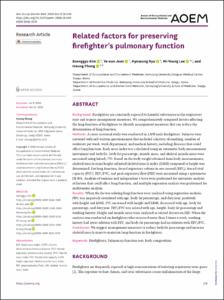KUMEL Repository
1. Journal Papers (연구논문)
1. School of Medicine (의과대학)
Dept. of Preventive Medicine (예방의학)
Related factors for preserving firefighter's pulmonary function
- Keimyung Author(s)
- Lee, Mi Young; Chung, In Sung
- Department
- Dept. of Preventive Medicine (예방의학)
- Journal Title
- Annals of Occupational and Environmental Medicine
- Issued Date
- 2020
- Volume
- 32
- Issue
- 4
- Abstract
- Background:
Firefighters are constantly exposed to harmful substances in the respiratory tract and require management measures. We comprehensively compared factors affecting the lung function of firefighters to identify management measures that can reduce the deterioration of lung function.
Methods:
A cross-sectional study was conducted in 1,108 male firefighters. Subjects were surveyed with self-written questionnaires that included a history of smoking, number of workouts per week, work department, and medical history, including diseases that could affect lung function. Body mass index was calculated using an automatic body measurement instrument and body fat, body fat percentage, muscle mass, and skeletal muscle mass were measured using Inbody 770. Based on the body weight obtained from body measurements, skeletal muscle mass height-adjusted skeletal muscle index (hSMI) compared to height was determined. For lung function, forced expiratory volume in one second (FEV1), forced vital capacity (FVC), FEV1/FVC, and peak expiratory flow (PEF) were measured using a spirometer HI-801. Analysis of variance and independent t-tests were performed for univariate analysis of factors that could affect lung function, and multiple regression analysis was performed for multivariate analysis.
Results:
When the factors relating lung function were analyzed using regression analysis, FEV1 was negatively correlated with age, body fat percentage, and duty year, positively with height and hSMI. FVC increased with height and hSMI, decreased with age, body fat percentage, and duty year. FEV1/FVC was related with age, height, body fat percentage and working history. Height and muscle mass were analyzed as related factors on PEF. When the analysis was conducted on firefighters who exercised more than 3 times a week, working history had lower relation with FEV1 and body fat percentage had no relation with FEV1/FVC.
Conclusion:
We suggest management measures to reduce body fat percentage and increase skeletal muscle mass to maintain lung function in firefighters.
- Publisher
- School of Medicine (의과대학)
- Citation
- Seonggyu Kim et al. (2020). Related factors for preserving firefighter’s pulmonary function. Annals of Occupational and Environmental Medicine, 32(4), e40. doi: 10.35371/aoem.2020.32.e40
- Type
- Article
- ISSN
- 2052-4374
- Source
- https://aoemj.org/search.php?where=aview&id=10.35371/aoem.2020.32.e40&code=2022AOEM&vmode=FULL
- Appears in Collections:
- 1. School of Medicine (의과대학) > Dept. of Preventive Medicine (예방의학)
- 파일 목록
-
-
Download
 oak-2020-0604.pdf
기타 데이터 / 660.45 kB / Adobe PDF
oak-2020-0604.pdf
기타 데이터 / 660.45 kB / Adobe PDF
-
Items in Repository are protected by copyright, with all rights reserved, unless otherwise indicated.